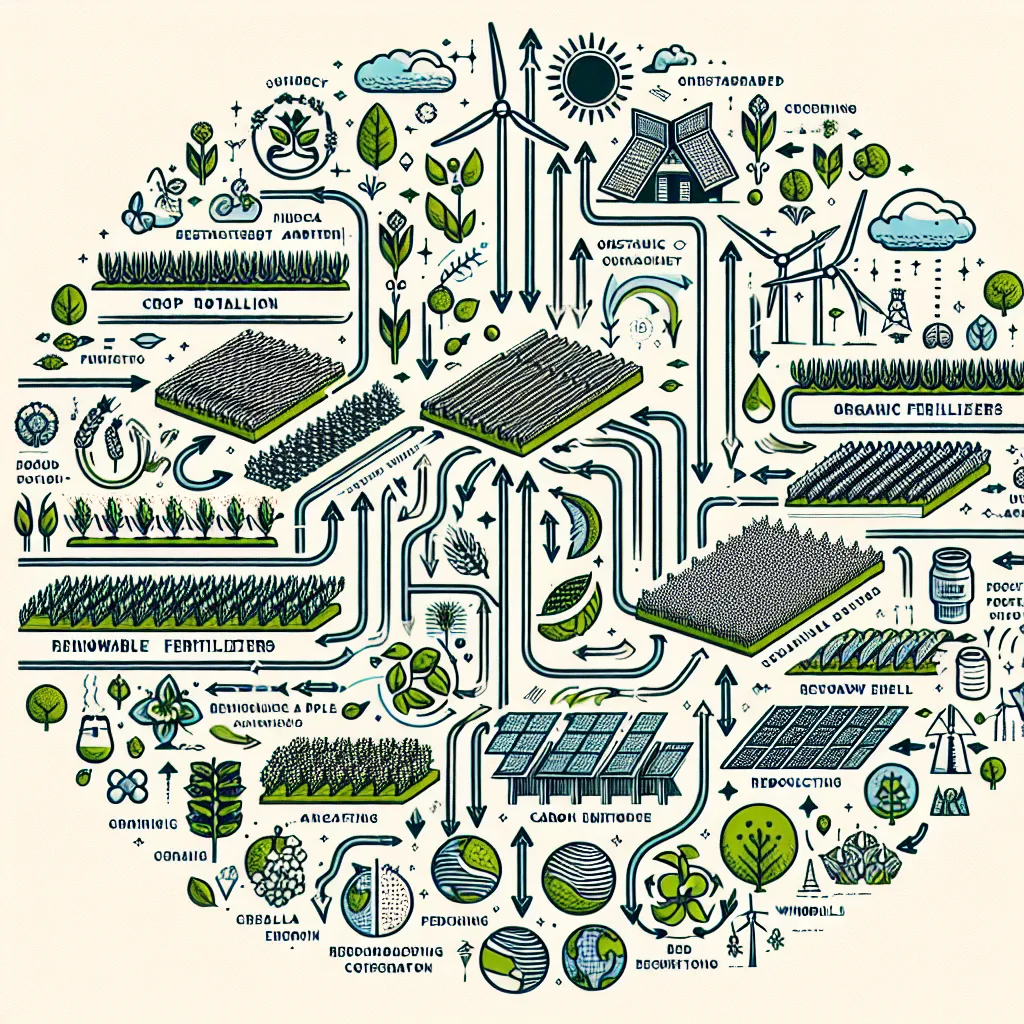As an experienced IELTS instructor, I’m excited to share with you a comprehensive IELTS Reading practice test focused on the crucial topic of “The role of sustainable farming in reducing carbon emissions.” This test will not only enhance your reading skills but also broaden your knowledge on sustainable agriculture and its impact on climate change mitigation.
 Sustainable farming practices reducing carbon emissions
Sustainable farming practices reducing carbon emissions
IELTS Reading Practice Test
Passage 1 – Easy Text
The Basics of Sustainable Farming
Sustainable farming is an agricultural approach that focuses on producing food in a way that is environmentally friendly, socially responsible, and economically viable. This method of farming aims to meet society’s present food needs without compromising the ability of future generations to meet their own needs. One of the key benefits of sustainable farming is its potential to significantly reduce carbon emissions, which are a major contributor to climate change.
Traditional farming methods often rely heavily on synthetic fertilizers, pesticides, and intensive tilling, all of which contribute to the release of greenhouse gases. In contrast, sustainable farming practices such as crop rotation, organic fertilization, and minimal tillage can help sequester carbon in the soil and reduce overall emissions.
Moreover, sustainable farming promotes biodiversity by maintaining a variety of crops and supporting natural ecosystems. This diversity not only helps in pest control naturally but also enhances the soil’s ability to store carbon. By incorporating agroforestry techniques, farmers can further increase carbon sequestration through the planting of trees alongside crops.
Water management is another crucial aspect of sustainable farming. Efficient irrigation systems and water conservation techniques not only save this precious resource but also reduce the energy required for pumping and distribution, thereby lowering carbon emissions indirectly.
Sustainable farming also emphasizes the use of renewable energy sources such as solar and wind power for farm operations. This shift away from fossil fuels significantly reduces the carbon footprint of agricultural activities.
By adopting these practices, sustainable farming plays a vital role in mitigating climate change while ensuring food security for a growing global population.
Questions 1-5
Do the following statements agree with the information given in the reading passage?
Write:
- TRUE if the statement agrees with the information
- FALSE if the statement contradicts the information
- NOT GIVEN if there is no information on this
- Sustainable farming aims to balance environmental, social, and economic factors.
- Traditional farming methods are more effective in reducing carbon emissions than sustainable farming.
- Crop rotation is a sustainable farming practice that can help reduce carbon emissions.
- Sustainable farming practices always lead to higher crop yields compared to traditional methods.
- The use of renewable energy in farming operations can help reduce the carbon footprint of agriculture.
Questions 6-10
Complete the sentences below.
Choose NO MORE THAN TWO WORDS from the passage for each answer.
- Sustainable farming practices can help __ carbon in the soil.
- __ is a sustainable farming technique that involves planting trees alongside crops.
- Efficient __ systems in sustainable farming help save water and reduce energy consumption.
- Sustainable farming promotes __, which helps in natural pest control and enhances soil carbon storage.
- By adopting sustainable practices, farming can play a crucial role in __ climate change.
Passage 2 – Medium Text
Innovative Sustainable Farming Techniques
The agricultural sector is witnessing a paradigm shift towards more sustainable practices, driven by the urgent need to address climate change. Innovative techniques in sustainable farming are not only helping to reduce carbon emissions but are also proving to be economically viable for farmers in the long run.
One of the most promising developments in this field is precision agriculture. This approach utilizes advanced technologies such as GPS, remote sensing, and data analytics to optimize crop yields while minimizing resource use. By precisely applying water, fertilizers, and pesticides only where and when they are needed, farmers can significantly reduce waste and, consequently, their carbon footprint.
Another groundbreaking technique is the use of biochar as a soil amendment. Biochar is a type of charcoal produced by burning organic matter in a low-oxygen environment. When added to soil, it not only improves soil fertility but also acts as a long-term carbon sink, effectively sequestering carbon for hundreds to thousands of years.
Vertical farming and hydroponics are revolutionizing urban agriculture. These methods allow for year-round crop production in controlled environments, often in urban settings close to consumers. By dramatically reducing transportation distances and optimizing resource use, these techniques can significantly lower the carbon emissions associated with food production and distribution.
The concept of regenerative agriculture is gaining traction as a holistic approach to farming. This method goes beyond sustainability to actively improve the health of the soil and ecosystem. Practices such as no-till farming, cover cropping, and managed grazing not only reduce emissions but can actually result in negative carbon farming, where more carbon is sequestered than emitted.
Agroforestry, the integration of trees and shrubs into crop and animal farming systems, is another powerful tool in the fight against climate change. This practice not only sequesters carbon in plant biomass and soil but also provides additional benefits such as improved soil health, increased biodiversity, and diversified income streams for farmers.
Bioenergy production integrated with farming systems is emerging as a win-win solution. Crops grown specifically for energy production, or agricultural waste converted into biofuels, can offset fossil fuel use while providing farmers with an additional source of income.
As these innovative techniques continue to evolve and become more widely adopted, the agricultural sector has the potential to transform from a significant source of greenhouse gas emissions to a powerful ally in the fight against climate change.
Questions 11-15
Choose the correct letter, A, B, C, or D.
-
According to the passage, precision agriculture:
A) Increases crop yields but uses more resources
B) Optimizes crop yields while reducing resource use
C) Only focuses on reducing water usage
D) Is not economically viable for most farmers -
Biochar is described as:
A) A type of fertilizer
B) A soil amendment that improves fertility and sequesters carbon
C) A technology used in precision agriculture
D) A form of vertical farming -
Vertical farming and hydroponics are said to reduce carbon emissions by:
A) Using less water than traditional farming
B) Producing larger crop yields
C) Reducing transportation distances and optimizing resource use
D) Eliminating the need for soil -
Regenerative agriculture is described as:
A) A method that only focuses on carbon sequestration
B) Less effective than traditional farming methods
C) A holistic approach that improves soil health and ecosystem
D) A technique only suitable for large-scale farming -
According to the passage, agroforestry:
A) Only benefits the environment
B) Reduces crop yields
C) Provides multiple benefits including carbon sequestration and income diversification
D) Is only suitable for animal farming systems
Questions 16-20
Complete the summary below.
Choose NO MORE THAN TWO WORDS from the passage for each answer.
Sustainable farming techniques are evolving to address climate change while remaining 16)__ for farmers. Precision agriculture uses technologies like 17)__ and data analytics to optimize resource use. 18)__ is a promising soil amendment that acts as a carbon sink. Urban agriculture methods like vertical farming reduce 19)__ associated with food distribution. Regenerative agriculture practices can result in 20)__, where more carbon is sequestered than emitted.
Passage 3 – Hard Text
The Economic and Policy Implications of Sustainable Farming for Carbon Reduction
The transition towards sustainable farming practices that effectively reduce carbon emissions is not merely an environmental imperative but also a complex economic and policy challenge. This shift requires a delicate balance between immediate economic considerations and long-term environmental benefits, necessitating a nuanced approach from policymakers, economists, and agricultural stakeholders.
One of the primary economic hurdles in adopting sustainable farming practices is the initial investment cost. Many carbon-reducing techniques, such as precision agriculture technologies or biochar production facilities, require significant upfront capital. This can be particularly challenging for small-scale farmers or those in developing countries with limited access to credit. However, studies have shown that these investments often lead to improved profitability in the medium to long term through increased yields, reduced input costs, and potential carbon credit revenues.
The carbon credit market presents a promising economic incentive for farmers to adopt sustainable practices. By quantifying and verifying the carbon sequestered or emissions reduced through sustainable farming methods, farmers can generate carbon credits that can be sold in voluntary or compliance markets. However, the complexity and cost of measuring, reporting, and verifying carbon sequestration in agricultural systems remain significant barriers to widespread participation in these markets.
Government policies play a crucial role in incentivizing the adoption of sustainable farming practices. Subsidies and tax incentives for sustainable agriculture can help offset initial costs and encourage farmers to transition to more environmentally friendly methods. However, policymakers must carefully design these incentives to avoid unintended consequences, such as overproduction or the displacement of emissions to other sectors or regions.
The concept of true cost accounting in agriculture is gaining traction among economists and policymakers. This approach aims to internalize the environmental and social costs of food production, including carbon emissions, into the price of agricultural products. While this could create a more level playing field for sustainable farming practices, it also raises concerns about food affordability and security, particularly for low-income populations.
International trade policies have significant implications for sustainable farming and carbon reduction efforts. While free trade can promote the efficient allocation of agricultural resources, it can also lead to carbon leakage, where strict environmental regulations in one country lead to increased production and emissions in countries with lax regulations. Balancing trade liberalization with environmental protection remains a key challenge in international agricultural policy.
The role of technological innovation in sustainable farming cannot be overstated. Advances in areas such as biotechnology, artificial intelligence, and robotics have the potential to dramatically reduce the carbon footprint of agriculture while improving productivity. However, ensuring equitable access to these technologies and addressing concerns about their long-term impacts on biodiversity and rural economies presents both economic and policy challenges.
Consumer behavior and market demand are increasingly influencing agricultural practices. The growing consumer preference for sustainably produced food creates market opportunities for farmers adopting low-carbon practices. However, price premiums for sustainable products may not always fully compensate for the additional costs incurred by farmers, necessitating a combination of market-based solutions and policy interventions.
As the agricultural sector grapples with the dual challenges of feeding a growing global population and mitigating climate change, the economic and policy landscape surrounding sustainable farming continues to evolve. Successful strategies will likely require a holistic approach that integrates economic incentives, supportive policies, technological innovation, and shifts in consumer behavior to create a truly sustainable and low-carbon agricultural system.
Questions 21-26
Complete the sentences below.
Choose NO MORE THAN THREE WORDS from the passage for each answer.
- One of the main economic challenges in adopting sustainable farming practices is the __.
- Studies have shown that investments in sustainable farming can lead to __ in the medium to long term.
- The __ offers an economic incentive for farmers to adopt sustainable practices.
- Government __ can help offset the initial costs of transitioning to sustainable farming methods.
- The concept of __ aims to include environmental and social costs in the price of agricultural products.
- Strict environmental regulations in one country can lead to __ in countries with less stringent rules.
Questions 27-33
Do the following statements agree with the claims of the writer in the reading passage?
Write:
- YES if the statement agrees with the claims of the writer
- NO if the statement contradicts the claims of the writer
- NOT GIVEN if it is impossible to say what the writer thinks about this
- The carbon credit market is currently the most effective way to encourage sustainable farming practices.
- Government subsidies for sustainable agriculture always lead to positive outcomes without any unintended consequences.
- True cost accounting in agriculture could potentially impact food affordability for some populations.
- International trade policies have no effect on sustainable farming and carbon reduction efforts.
- Technological innovations in agriculture are guaranteed to reduce carbon emissions without any negative impacts.
- Consumer demand for sustainably produced food always results in higher profits for farmers adopting these practices.
- A combination of economic incentives, policies, and technological innovation is likely needed for successful sustainable farming strategies.
Questions 34-40
Complete the summary below.
Choose NO MORE THAN TWO WORDS from the passage for each answer.
The transition to sustainable farming practices that reduce carbon emissions presents both environmental and 34)__ challenges. While there are significant 35)__ costs, these investments often lead to improved profitability over time. The 36)__ market offers potential economic incentives, but participation is hindered by measurement and verification complexities. Government 37)__ play a crucial role in encouraging adoption, but must be carefully designed. The concept of 38)__ in agriculture aims to internalize environmental costs but raises concerns about food affordability. 39)__ have significant implications for sustainable farming efforts, potentially leading to carbon leakage. 40)__ in areas such as biotechnology and AI have the potential to reduce agriculture’s carbon footprint, but equitable access remains a challenge.
Answer Key
Passage 1
- TRUE
- FALSE
- TRUE
- NOT GIVEN
- TRUE
- sequester
- Agroforestry
- irrigation
- biodiversity
- mitigating
Passage 2
- B
- B
- C
- C
- C
- economically viable
- GPS
- Biochar
- transportation distances
- negative carbon farming
Passage 3
- initial investment cost
- improved profitability
- carbon credit market
- subsidies
- true cost accounting
- carbon leakage
- NO
- NO
- YES
- NO
- NO
- NO
- YES
- economic
- initial
- carbon credit
- policies
- true cost accounting
- International trade policies
- Technological innovation
Conclusion
This IELTS Reading practice test on “The role of sustainable farming in reducing carbon emissions” provides a comprehensive overview of the topic while challenging your reading comprehension skills. Remember to practice regularly and familiarize yourself with various question types to improve your performance. For more IELTS preparation resources, check out our articles on urban farming and sustainable living tips.
Good luck with your IELTS preparation!


